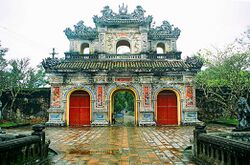Kiếm Hoà Dynasty
This article is incomplete because it is pending further input from participants, or it is a work-in-progress by one author. Please comment on this article's talk page to share your input, comments and questions. Note: To contribute to this article, you may need to seek help from the author(s) of this page. |
Kiếm Hoà Dynasty Ratchawong Khewinphumiphrakun 劍和朝 ราชวงศ์ เควนกหเวนผู้มีพระคุณ | |||||||||
|---|---|---|---|---|---|---|---|---|---|
| 1267–1500 | |||||||||
|
Flag | |||||||||
| File:KiemHoaDynasty-Map.png | |||||||||
| Capital | |||||||||
| Common languages | Quenminese, Tamauese | ||||||||
| Religion | Haimeism (official), Sofianism | ||||||||
| Government |
| ||||||||
| Emperor | |||||||||
• 1267-1300 | Chuyển Bình | ||||||||
• 1304-24 | Chính Phúc | ||||||||
• 1496-1500 | Tôn Lễ | ||||||||
| Legislature | Imperial Court | ||||||||
• Upper House | Advisory Council | ||||||||
• Lower House | Council of Lords | ||||||||
| History | |||||||||
• Establishment of the Dynasty | 14 February 1267 1267 | ||||||||
• Succession by the House of Đường Bộ | 24 July 1339 | ||||||||
• Independence of the Mahathum Kingdom | 18 September 1392 | ||||||||
| 19 May 1440 1500 | |||||||||
| Currency | Văn | ||||||||
| |||||||||
Part of a series on the |
|---|
| History of Quenmin |
 |
The Kiếm Hoà dynasty (Vietnamese: Nhà Kiếm Hoà) was a imperial Quenminese dynasty that was formed in 1267 during the waning years of the Third Quenminese Anarchy. It ruled over Quenmin for 233 years, and possessed an extensive empire that stretched from the Quenminese homeland to Tennai facing the Ruadak Sea. The dynasty also formed a personal union with the Arantho Kingdom until the latter's independence in 1392, with the dynasty's rulers taking Tamauese or Sanskrit regnal names. Due to this, the Dynasty also earned the Tamauese name Khewinphumiphrakun Dynasty (ราชวงศ์ เควนกหเวนผู้มีพระคุณ; Ratchawong Khewinphumiphrakun), from one of their titles that translates to "Quenic Benefactor." With its territorial gains and political influence, the dynasty ushered in an era of cosmopolitanism from the cultures and nations it reigned over.
Kiều Thạc Nhu, who was Countess of Khoái Siêu, proclaimed herself Empress of the newly-formed dynasty to reunify Đại Quến during the Anarchy. The other warlords challenged her, but ended with their defeat during her campaigns against them. She then relocated the dynasty's capital to Tamcai. Years later, the neighboring Tuntayakul Kingdom was subjected to Kiếm Hoà sovereignty at the end of the Kiem Hoa-Tuntayakul War and its dynasty was overthrown. Nhu subsequently established a personal union with the Tayamese via the creation of the Arantho Kingdom, permitting self-governance while its people recognized her rule and accorded to the dynasty's foreign policies; this was considered a rarity among the Quenminese dynasties. Nhu then expanded further south to subjugate the Nambyan Republic and gain territory from the Rideva Empire. After her assassination, Đại Quến managed to recover from the Anarchy and become an immensely prosperous state, surpassing that of the Liễu Dynasty. Rule shifted from the House of Kiều Thạc to the House of Đường Bộ after the deposition of Bảo Hưng, bearing resemblance to the succeeding dynasties of the ancient Hồng Bàng era. The dynasty's greatest extent was reached under Chính Phúc, Đường Bộ's first monarch.
The personal union lasted until the independence of the Mahathum Kingdom during the rule of Xương Phù in 1392. Despite the loss of the Arantho Kingdom, the dynasty still prospered with its economy recovering quickly under Chượng Tông's reign. The final house to rule the dynasty was Thái Lam clan, and while producing several successful emperors, most were underperforming or inept. Eventually, the dynasty lost its power and influence in 1500 under the rule of Tôn Lễ, with several noble families establishing their own dynasties in the Nothern and Southern Dynasties Era.